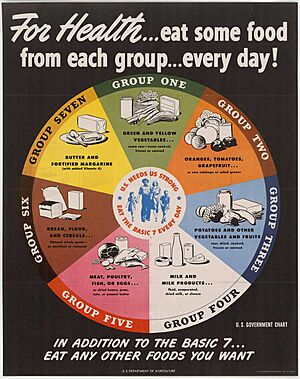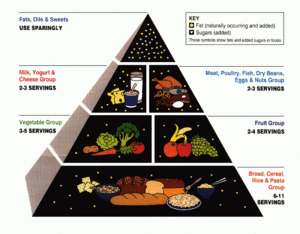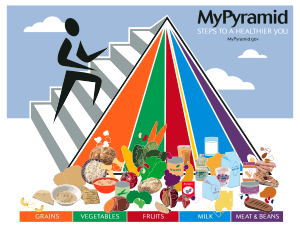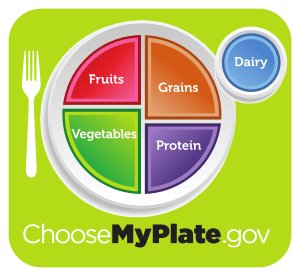History of USDA nutrition guidelines facts for kids
The history of USDA nutrition guidelines tells the story of how the United States Department of Agriculture (USDA) has given advice on healthy eating for over 100 years. These guidelines are updated often to include new scientific discoveries and better ways to share health messages. The current advice is found in the Dietary Guidelines for Americans and the MyPlate guide. Sometimes, these guidelines have faced criticism, with some people saying they don't always reflect the latest science or are too influenced by food industries.
Contents
Early Nutrition Guides
The USDA's first advice on nutrition came out in 1894. It was written by Dr. Wilbur Olin Atwater for farmers. In 1904, Dr. Atwater suggested eating a variety of foods in moderation. He also talked about counting calories and choosing affordable, nutrient-rich foods with less fat, sugar, and starch. This advice was given before individual vitamins were fully discovered.
In 1916, nutritionist Caroline Hunt created a new guide called Food for Young Children. It sorted foods into groups like milk and meat, cereals, and vegetables and fruits. The next year, How to Select Food shared these five food groups with adults. These ideas stayed popular through the 1920s. During the Great Depression in 1933, the USDA even offered food plans based on different costs.
By 1941, the first Recommended Dietary Allowances were made. These listed specific amounts needed for calories, protein, iron, calcium, and vitamins A, B1, B2, B3, C, and D.
The Basic 7 Food Groups
During World War II in 1943, the USDA introduced the "Basic 7" food groups. This guide helped people eat well even with wartime food rationing. The seven food groups were:
- Green and yellow vegetables (some raw, some cooked, frozen, or canned)
- Oranges, tomatoes, grapefruit (or raw cabbage or salad greens)
- Potatoes and other vegetables and fruits (raw, dried, cooked, frozen, or canned)
- Milk and milk products (liquid, evaporated, dried milk, or cheese)
- Meat, poultry, fish, or eggs (or dried beans, peas, nuts, or peanut butter)
- Bread, flour, and cereals (natural whole grain, or enriched or restored)
- Butter and fortified margarine (with added Vitamin A)
The Basic Four Food Groups
From 1956 to 1992, the USDA suggested its "Basic Four" food groups. These groups were:
- milk
- meat
- fruit and vegetables
- bread and cereals
"Other foods" were meant to complete meals and help you feel full. These included extra servings from the Basic Four, or foods like butter, salad dressing, and syrups. The Basic Four guide was very common in nutrition education. A good example is the 1972 TV show Mulligan Stew, which taught schoolchildren about nutrition.
Food Guide Pyramid
In 1992, the USDA introduced the food guide pyramid. This new guide tried to show how many servings of each food group people should eat. The largest part at the bottom of the pyramid was for bread, cereal, rice, and pasta (6 to 11 servings). Next came vegetables (3 to 5 servings), then fruits (2 to 4 servings). Above that were milk, yogurt, and cheese (2 to 3 servings), followed by meat, poultry, fish, dry beans, eggs, and nuts (2 to 3 servings). The very top, the smallest part, was for fats, oils, and sweets, which should be used sparingly. The pyramid also showed pictures of foods and symbols for fat and sugar content.
A special food pyramid was also created for adults over 70. This "Modified Food Pyramid for 70+ Adults" focused on drinking enough water and eating foods rich in nutrients and fiber, as diets change with age.
MyPyramid
In 2005, the USDA updated its guide to MyPyramid. This new design changed the pyramid's layers into colorful vertical wedges. Often, it didn't show pictures of foods, making it look more abstract. Stairs were added up the left side with a person climbing them, encouraging exercise. In MyPyramid, grains still had the largest share, but vegetables and milk were almost as big. Fruits came next, then a smaller wedge for protein, and a tiny sliver for oils. A blank white tip showed "discretionary calories," which were extra calories for treats like candy or more food from any group.
MyPlate
MyPlate is the current nutrition guide from the United States Department of Agriculture. It's a simple picture of a plate and a glass divided into five food groups. MyPlate replaced the MyPyramid in 2011, ending 19 years of food pyramid designs. The plate is divided into four sections: two slightly larger ones for vegetables and grains, and two slightly smaller ones for protein and fruits. A circle next to the plate represents dairy, like a glass of milk. This guide is often seen on food packaging and is used to teach about nutrition across the United States.
Dietary Guidelines for Americans
The Center for Nutrition Policy and Promotion (part of the USDA) and the United States Department of Health and Human Services work together to release a longer document called Dietary Guidelines for Americans. The first edition came out in 1980, and since 1985, it has been updated every five years. These guidelines are created by the Dietary Guidelines Advisory Committee.
Sometimes, these guidelines have been criticized. For example, in 2015, the committee considered how diet affects the environment for the first time. Their report suggested that a healthy diet should include more plant-based foods and fewer animal-based foods. They also found that a plant-based diet was better for the environment than one based on meat and dairy.
Some research has also questioned the data used to create the guidelines. However, the goal of these guidelines is always to help people make healthy food choices. The latest guidelines, the 2020–2025 edition, were released in 2020.
See also
- List of nutrition guides
- 5 A Day
- Fruits & Veggies – More Matters
- Nutrition facts label





